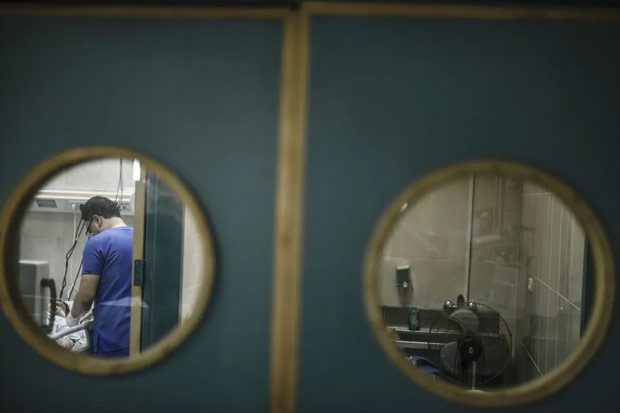‘Absolutely Horrific.’ What American Volunteer Doctors Saw in Gaza
Time,

John Kahler once again heard the sound, the wailing. Inside a room at MedGlobal’s wound care clinic in Rafah, another one of the 150 to 200 patients seen a day was simply having their wounds cleaned. But this was Gaza, and medical supplies are limited or tapped out entirely.
“Wound care usually means debridement—you have to scrub all the crap off the burn or the wound. That stuff is extremely painful and there’s no anesthesia, and so from seven in the morning until the last patient is seen, you just hear this wail,” he says. “It’s just—it’s heartbreaking.”
Kahler is cofounder of MedGlobal, a nonprofit that has doctors, nurses, and specialists operating around the world. But, he says in a phone call, that despite his experience in various crises, including Haiti after the 2010 earthquake and in war-torn Yemen, he “wasn’t anywhere near prepared for this.”
In some ways, the horror of Gaza can be expressed in staggering statistics. The Gaza Ministry of Health puts the death toll since Oct. 7 at more than 30,000. The U.N. warns that more than 1 million Palestinians face “emergency” levels of food insecurity, and that the danger facing 500,000 others is “catastrophic.” The World Health Organization has found children dying of starvation or suffering from malnutrition.
These statistics are buttressed by stark, disturbing footage of Israel’s bombardment of the Strip. All of this has played out in a social media age. Yet the images don’t capture the full reality facing Gazans or the medical community treating them that is in non-stop crisis mode.
“We’re just seeing shrapnel injuries I’ve never seen before,” says Nahreen Ahmed, a critical care doctor at the University of Pennsylvania and medical director of MedGlobal. “They shred through the body, creating injuries that are just really absolutely horrific.”
Ahmed says that the deaths of so many children in particular is hard to stomach. Some coming into the emergency room at Nasser Hospital who had sustained blast injuries looked “like they were sleeping.” Many were dead on arrival. “One night I think we saw seven dead children under the age of five in the course of like four or five hours,” she said in a call. According to the Gaza Ministry of Health, 12,000 children have died since the war began.
Major charities like Doctors Without Borders, the International Medical Corps, the International Rescue Committee, the Red Cross, and the WHO say they face a hydra-headed problem in Gaza. The sheer mass of wounded and ill is one thing, complicated by the fact that most hospitals are no longer functioning. Not long after Ahmed left Gaza to return to the U.S., for example, Israeli forces raided Nasser Hospital, where she volunteered for 20 days in January. The hospital, which was also being used as a shelter by thousands of civilians, no longer operates as a care facility.
Where hospitals continue to operate, there are staff shortages. Most Palestinian aid workers, including doctors, have been displaced in the Strip, and many can’t get to the hospitals and clinics where they normally serve, according to the International Rescue Committee.
The doctors with whom I spoke told stories of the crushing need for care that outstripped all available resources and sometimes forced awful decisions about whom to treat.
Joint Jordan-U.S. airdrops of food and medicines began two weeks ago, joining efforts of several other countries. But international aid groups have criticized the efforts as inefficient and too small to make a meaningful difference. One drop even killed Gazans when a parachute failed to open.
If a threatened ground incursion by the Israeli military into Rafah materializes, an already dire situation may grow only more so. It was already “mass casualty after mass casualty coming in through the emergency room,” Ahmed says. With resources as scarce as they are, it sometimes only took four or five patients to overwhelm an emergency room. “And oftentimes, it was much more than that,” she adds, “and mostly children.”
This article originally appeared on https://time.com/6910949/gaza-american-doctor-volunteers/
